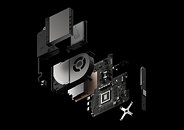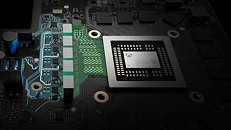Monday, June 12th 2017

Xbox One X Hardware Specs Give Gaming Desktops a Run for their Money
Microsoft Sunday dropped its mic with the most powerful game console on paper, the Xbox One X, formerly codenamed "Project Scorpio." The bottom-line of this console is that it enables 4K Ultra HD gaming at 60 Hz. Something like this requires you to spend at least $1,200 on a gaming desktop right now. Unlike a Windows 10 PC that's been put together by various pieces of hardware, the Xbox One X is built on a closed ecosystem that's tightly controlled by Microsoft, with heavily optimized software, and a lot of secret sauce the company won't talk about. The console still puts up some mighty impressive hardware specs on paper.
To begin with, at the heart of the Xbox One X is a semi-custom SoC Microsoft co-developed with AMD, built on TSMC's 16 nm FinFET node (the same one NVIDIA builds its "Pascal" GPUs on). This chip features a GPU with almost quadruple the single-precision floating point compute power as the one which drives the Xbox One. It features 40 Graphics CoreNext (GCN) compute units (2,560 stream processors) based on one of the later versions of GCN (likely "Polaris"). The GPU is clocked at 1172 MHz. The other big component of the SoC is an eight-core CPU based on an unnamed micro-architecture evolved from "Jaguar" rather than "Bulldozer" or even "Zen." The eight cores are arranged in two quad-core units of four cores, each; with 4 MB of L2 cache. The CPU is clocked at 2.30 GHz.The third major component of the Xbox One X SoC is the 384-bit wide GDDR5 memory controller, wired to 12 GB of memory. This memory is used both as system- and graphics-memory, and is the most ideal implementation of AMD's hUMA (heterogeneous unified memory architecture), where there's no visible partition between the system and graphics memory on the physical memory, and depending on the usage scenario, any amount of memory can be used by the CPU and GPU components. Developers are still forced to build their games under the assumption that the system only has 8 GB of memory; so that the remaining 4 GB is used as a kind of "guarantee" that 4K UHD @60 Hz runs smoothly. The total memory bandwidth available is a staggering 326 GB/s.
The SoC features an integrated audio CODEC with 7.1-channel output over HDMI, with support for Dolby Atmos, and HRTF, a new audio format Microsoft developed for the Hololens, which is optimized for VR.
A 1 TB 2.5-inch SATA hard drive comes standard on the Xbox One X. You can swap this drive out for larger HDDs, or faster SATA SSDs. You can also plug in external storage devices over the console's USB 3.0 ports. The console's operating system resides on a smaller eMMC chip that isn't accessible to end-users. The 1 TB HDD is used to store games you've downloaded from your online library à la Steam.
Microsoft switched from bulky external power bricks to internal PSUs with the Xbox One S, and the trend carries forward with the Xbox One X. Powering the whole thing is a 275W internal power-supply. A large fan-heatsink cools the SoC and GDDR5 memory chips.
Source:
Eurogamer.net
To begin with, at the heart of the Xbox One X is a semi-custom SoC Microsoft co-developed with AMD, built on TSMC's 16 nm FinFET node (the same one NVIDIA builds its "Pascal" GPUs on). This chip features a GPU with almost quadruple the single-precision floating point compute power as the one which drives the Xbox One. It features 40 Graphics CoreNext (GCN) compute units (2,560 stream processors) based on one of the later versions of GCN (likely "Polaris"). The GPU is clocked at 1172 MHz. The other big component of the SoC is an eight-core CPU based on an unnamed micro-architecture evolved from "Jaguar" rather than "Bulldozer" or even "Zen." The eight cores are arranged in two quad-core units of four cores, each; with 4 MB of L2 cache. The CPU is clocked at 2.30 GHz.The third major component of the Xbox One X SoC is the 384-bit wide GDDR5 memory controller, wired to 12 GB of memory. This memory is used both as system- and graphics-memory, and is the most ideal implementation of AMD's hUMA (heterogeneous unified memory architecture), where there's no visible partition between the system and graphics memory on the physical memory, and depending on the usage scenario, any amount of memory can be used by the CPU and GPU components. Developers are still forced to build their games under the assumption that the system only has 8 GB of memory; so that the remaining 4 GB is used as a kind of "guarantee" that 4K UHD @60 Hz runs smoothly. The total memory bandwidth available is a staggering 326 GB/s.
The SoC features an integrated audio CODEC with 7.1-channel output over HDMI, with support for Dolby Atmos, and HRTF, a new audio format Microsoft developed for the Hololens, which is optimized for VR.
A 1 TB 2.5-inch SATA hard drive comes standard on the Xbox One X. You can swap this drive out for larger HDDs, or faster SATA SSDs. You can also plug in external storage devices over the console's USB 3.0 ports. The console's operating system resides on a smaller eMMC chip that isn't accessible to end-users. The 1 TB HDD is used to store games you've downloaded from your online library à la Steam.
Microsoft switched from bulky external power bricks to internal PSUs with the Xbox One S, and the trend carries forward with the Xbox One X. Powering the whole thing is a 275W internal power-supply. A large fan-heatsink cools the SoC and GDDR5 memory chips.




132 Comments on Xbox One X Hardware Specs Give Gaming Desktops a Run for their Money
Controllers were made to be good all around gaming devices. You can have people be good at FPS games with a controller but that will never overcome it's technical limitations. There's a reason aim assist is in nearly every console FPS and there's a reason Overwatch competitive on console is played and balanced differently.
Will Volta finally allow PC peasants to run 4k blu ray or will they have to wait for 6 core Ice lake running at 5 ghz and Windows 11?
4k Streaming argument in 3, 2, ......
And remember how the cell cpu in the ps2 was hundreds of times more powerful than your home pc before it released...
I think a large part of the problem for console gaming is that game dev's are doing a really good job getting the most out of the gpu's nowadays(it has been roughly the same gcn backbone since the xb360 after all) and you dont get that improvement in quality across the lifetime of the console as you did on older generations as people learned to code for them better.
This is (part of) why we have mid-lifecycle .5 consoles coming out nowPS4 pro cant?
No, ps4 pro can't play BR4k. Ironically, the 'last gen' XB1s can. Strange since Sony pushed blu ray and Microsoft pushed HDDVD yet MS is 1.5 generations ahead on BR4k
store.steampowered.com/hwsurvey/videocard/
PCMR: please clean up your own peasants before complaining that consoles are holding you back.
-whats the power consumption of the gpu of this beast console?
I figured there was an agenda there since it is such an easy Google search.
Gpu is similar to an rx 580, so whatever that is.
You can take any cheap quad core i5 (or even Ryzen) and throw in a $200 GTX 1060 and it will outperform a $500 Xbox One X, or you can buy a $500 GTX 1080 which will perform >75% better. And even better, two-three years down the road you can spend a few hundred bucks more and get something that's good enough to play newer games, making your computer a great investment.
~10 years ago people were predicting that the PC gaming market were doomed, but instead the consoles have stagnated and then declined, while the PC gaming market keep growing. The only selling point for consoles are their exclusives, but that's also their hard selling point for the general public. Most buyers get very few console games, which makes the actual price of the console games very high, and buying multiple consoles gets ridiculously expensive. For those who are not fans of specific series, PCs remains the superior choice for gaming.
The slower CPU would not be an issue, GPU's are on par AND console is actively targeted.
Check Doom's benchmarks to see how it gets reflected in actual performance.
As mentioned, there is nothing making the consoles perform better per theoretical performance. It's the same type of hardware running the same APIs.
Targeting on consoles is about fine-tuning the load to hit a certain frame rate, making the rendered image look different from desktop, not about better performing hardware.
Xbox One X still uses an old Jaguar CPU, a 3 GHz i5 will probably be nearly twice as fast.